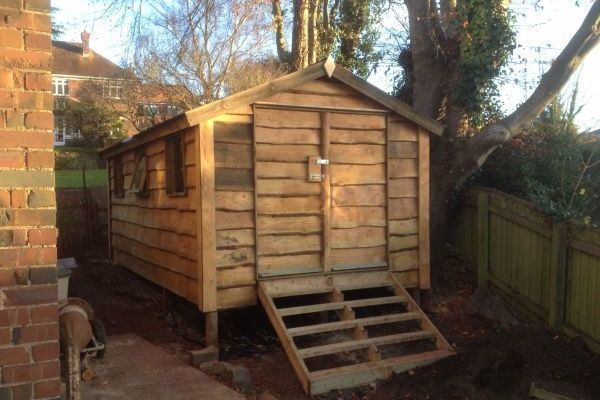Blueprints To Assemble 16 x 14 Hip Roof Outbuilding : Few Hints For Constructing A Shed Professionally

Check that the planks are level as you don't want your backyard shed to be uneven. Metal exterior shingles and metal gutters result in a long roof lifespan. Most of assembly work could be done down on the ground. Adding drip edge and felt paper to your roof before putting down shingles is definitely an option. The concrete wedge anchors secure ledger to wall. Fit timber to the inside of the shed. Slide panel up the roof until the bird’s-mouths drop over top plate of the wall. These fasteners are very strong but zip right in without (https://shedconstructionplans.com/30x72-pole-machine-shed-plans-blueprints) pilot holes. Remember to get all surfaces that will be painted and not just the obvious ones.
Laying out a square footprint and making side beams parallel with the ridge beam makes cutting rafters so much easier at this stage. The easiest method of erecting rafters is to make temporary braces of 2-by materials. Saw the pieces of the first truss to its length and set it down between the erected stakes. If you plan to use rollers then ensure that you have a brush to help even out edges. Painting the storage shed floor helps protect and seal the wood, it reduces splinters, makes it easier to clean, and it looks so much better. If your patio shed site slopes, pouring concrete is a bigger job because you have to construct strong forms and pour extra concrete on the downhill side.
If you want a screen, you’ll have to build a separate frame and staple screening to it. Step stringers are support pieces at the sides of the structure that hold up the steps you walk on. Before building all your trusses (visit) needed, ensure after building your first truss that it actually will fit properly on top plates. Make a backyard shed into a new space with interior and exterior paint. Hold the square in place with the base along plumb craft line, and mark the level line of the bird’s mouth. Use hurricane ties to secure rafters, prevent any wind lift and decrease chances of splitting.
Processing video...
Follow manufacturer's instructions to connect the vinyl siding and secure it to the oriented strand board with nails. Cut the rafter at the ridge line and at overhang line. Bevel the bottom edge of board using a 45-degree router bit prior to installing skirt board. Install the plywood roof sheathing over rafters to create the subroof. The whole perimeter of frame locks together at corners and the floor joists just drop into notches. You could use the speed square to draw a line perpendicular to the board edge with it. Cut section of the ridge that extends out for extra support at top of overhanging rake.
Jacks cope easily with a gently sloping base. Mark the locations for your ramp stringers beforehand to ensure the lag screws aren’t in the way. Used pieces of wood that were left over from cutting the studs for leveling. If you want to cut corners, consider buying a prefabricated utility shed that only needs to be installed, not built, on your site. The two types of doors most commonly used on outbuildings are hinged and sliding, and both work well. Level and square the 6x6s and you’re ready to build and attach joist system. Align edge of your jig on the mark and draw a plumb line that represents outside face of the fascia.
Attach temporary bracing to hold walls plumb. You can set your foundation directly on leveled ground. Stagger your floor sheeting when building your storage shed floor. Adding a cupola to your patio outbuilding will further enhance its charming appeal. Plus, you’ll have a greater color selection if you order the roofing rather than buy off-the-shelf panels. Putting a simple bookshelf in your backyard shed is a great way to store gardening items, tool boxes, or unused vases. Fix a frame of 2x10 into hole and then with fairly sturdy hinges attach door. This is best accomplished using gussett plates made from half inch plywood or OSB material.
Blow out dust, fill hole with epoxy, and insert rod to the required depth. Use a sawzall and cut off the leftover piece of stringer on each side.